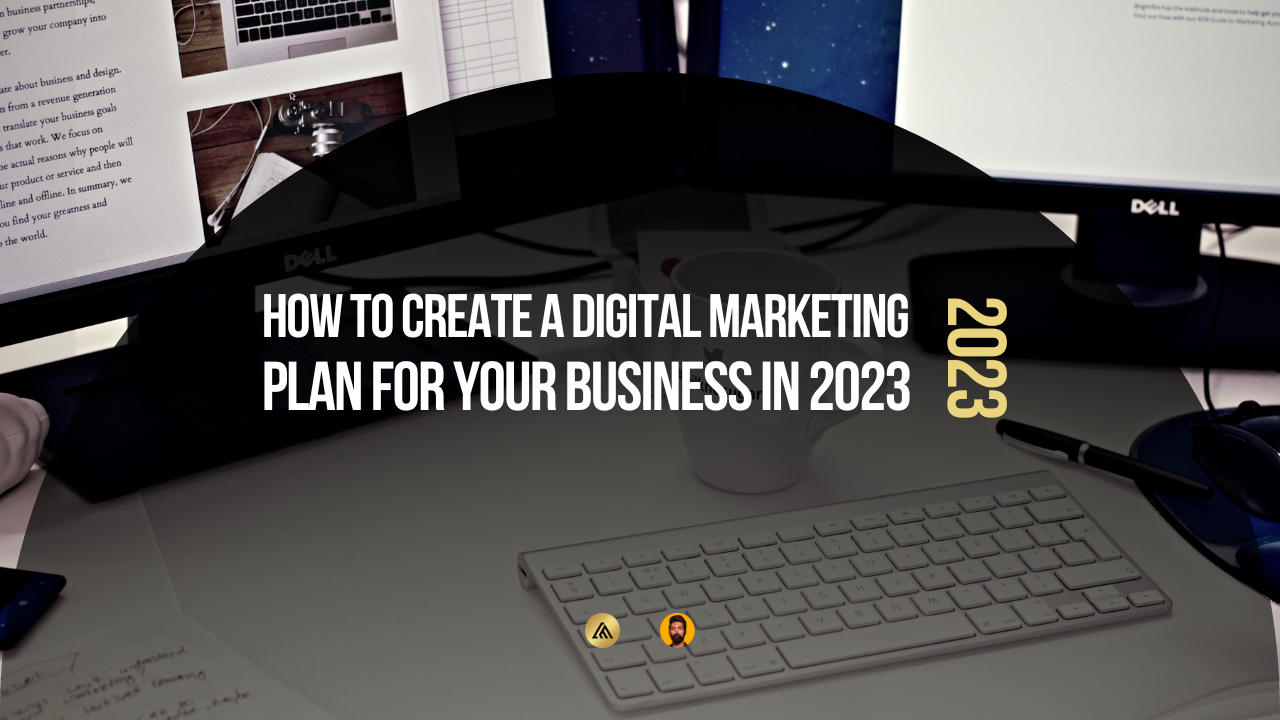Do you want to grow your business online and reach more customers? Do you want to stay ahead of your competitors and adapt to the changing digital landscape?
Do you want to create a digital marketing plan that works for your unique goals and challenges?
If you answered yes to any of these questions, then this blog post is for you.
In this post, I will show you how to create a digital marketing plan for your business in 2023.
You will learn:
What a digital marketing plan is and why do you need one?
How to define your digital marketing goals and budget?
How to build buyer personas to define your ideal audience?
How to analyze your competitors and market position?
How to choose which digital marketing channels to focus on?
How to set defined metrics to review and improve performance?
How to get stakeholder buy-in and break marketing projects into actionable tasks?
How to design and optimize your digital marketing content and assets?
How to invite and respond to feedback, questions, and suggestions?
How to use keywords, meta tags, links, and other SEO elements?
How to test, measure, and improve a digital marketing plan?
By the end of this post, you will have a clear and comprehensive digital marketing plan that will help you achieve your business objectives in 2023. Let’s get started!
What Is a Digital Marketing Plan and Why Do You Need One?
A digital marketing plan is a document in which you strategically map out your digital marketing objectives, as well as the actions you will take to achieve those objectives.
Among other things, it can include:
Business Goals: What are the overall outcomes you want to achieve with your digital marketing efforts?
Digital Strategies: What are the high-level approaches you will use to meet your business goals?
Objectives: What are the specific, measurable, attainable, relevant, and time-bound (SMART) targets you will set for each strategy?
Tactics: What are the specific actions you will take to implement each strategy and objective?
Timelines: When will you start and finish each tactic?
Budgets: How much money will you allocate for each tactic?
Digital Channels: Which online platforms and tools will you use for each tactic?
Metrics: How will you measure the success of each tactic and objective?

Think of a digital marketing plan as a roadmap of sorts. You know where you want to go, and the plan provides you with a specific route to follow.
Without a well-defined plan in place, your digital marketing efforts will be inefficient and ineffective. You will likely waste money and see diminished returns.
A clear plan helps you:
Align your digital marketing activities with your business vision and mission.
Identify and prioritize your most important opportunities and challenges.
Focus on the most relevant and impactful digital marketing channels.
Coordinate and integrate your digital marketing initiatives for greater synergy.
Track and optimize your digital marketing performance for continuous improvement.
A digital marketing plan is not a one-time document that you create and forget.
It is a living document that you should review and update regularly based on changing market conditions, customer feedback, competitor actions, and performance results.
How to Create a Digital Marketing Plan for Your Business in 2023
Now that you know what a digital marketing plan is and why you need one, let’s talk about how to create one for your business in 2023.
Here are the steps to follow:
Step 1: Define Your Digital Marketing Goals and Budget
The first step in creating a digital marketing plan is to define your digital marketing goals and budget.
These are the foundation of your plan, as they will guide all your subsequent decisions.
Your digital marketing goals should be aligned with your business goals.
What are the overall outcomes you want to achieve with your digital marketing efforts?
For example, do you want to:
Increase brand awareness and visibility.
Generate more leads and sales.
Build customer loyalty and retention.
Enhance customer satisfaction and advocacy.
Improve operational efficiency and profitability.
Your Digital Marketing Goals Should Also Be SMART
That means they should be:
Specific: Clearly state what you want to achieve.
Measurable: Include numbers or indicators that can be tracked.
Attainable: Be realistic and achievable with the resources available.
Relevant: Be aligned with your business vision and mission.
Time-bound: Have a deadline or timeframe for completion.

For example, instead of saying that you want to increase brand awareness, a SMART goal would be:
Increase website traffic by 50% by December 31st, 2023.
Your digital marketing budget should be based on your goals, as well as your current situation.
How much money can you afford to invest in your digital marketing activities?
How much money do you need to achieve your desired results?
How will you allocate your budget across different tactics and channels?
Your budget should also be flexible enough to allow for adjustments based on changing circumstances.
For example, if a tactic is performing well, you may want to increase its budget. If a tactic is underperforming, you may want to reduce or eliminate its budget.
Step 2: Build Buyer Personas to Define Your Ideal Audience
The second step in creating a digital marketing plan is to build buyer personas to define your ideal audience.
Buyer personas are fictional representations of your ideal customers based on real data and research.
They help you understand who your customers are, what they want, how they behave, and how they make decisions.
To create buyer personas, you need to conduct market research using both quantitative (surveys, analytics) and qualitative (interviews, focus groups) methods.
You can also use existing data sources such as customer feedback, reviews, testimonials, social media comments, etc.
Some of the information you need to collect for each buyer persona include:
Demographics: Age, gender, location, income level, education level, etc.
Psychographics: Interests, hobbies, values, beliefs, attitudes, etc.
Behaviors: Online habits, preferred channels, media consumption patterns, purchase frequency, loyalty level, etc.
Needs: Problems, challenges, pain points, goals, desires, etc. that they have or face.
Solutions: Products, services, features, benefits, etc. that they look for or use to address their needs.
Motivations: Reasons, factors, incentives, etc. that influence their decision-making process.

Once you have collected enough data for each buyer persona, give them a name (e.g., Marketing Manager Mary), a photo (e.g., from stock images), and a brief description (e.g., Mary is a 35-year-old marketing manager who works for a small B2B company).
You can also use tools like HubSpot’s Make My Persona or Xtensio’s User Persona Creator to create visually appealing buyer personas.
Creating buyer personas will help you:
Segment your audience into different groups based on their characteristics and needs.
Tailor your message, offer, and value proposition for each group.
Create relevant, engaging, and personalized content and experiences for each group.
Choose the best channels, platforms, and tools to reach each group.
Step 3: Analyze your competitors and market position
The third step in creating a digital marketing plan is to analyze your competitors and market position.
This will help you understand where you stand in relation to other players in your industry or niche. It will also help you identify opportunities and threats that may affect your performance.
To analyze your competitors, start by identifying who they are. You can use tools like Google Search, Google Trends, or SimilarWeb to find out who is ranking well for keywords related to your products or services.
You can also use tools like SpyFu, SEMrush, or Moz to get insights into their SEO, PPC, and social media strategies.
Then, evaluate their strengths, weaknesses, opportunities, and threats (SWOT).
Some of the aspects you can look at include:
Their products, services, features, benefits, prices, etc.
Their value proposition, brand identity, mission, vision, etc.
Their target audience, buyer personas, customer segments, etc.
Their website design, usability, navigation, content, etc.
Their SEO performance, keyword rankings, traffic sources, backlinks, etc.
Their PPC performance, ad copy, landing pages, budgets, etc.
Their social media presence, followers, engagement, content types, etc.
Their email marketing strategy, subject lines, content, frequency, open rates, click-through rates, etc.
Their customer reviews, testimonials, feedback, ratings, etc.
To analyze your market position, compare yourself with your competitors based on different criteria such as product quality, price, customer service, brand awareness, market share, etc.
You can use tools like SWOT Analysis to assess the attractiveness, competitiveness, and profitability of your market, and Porter’s Five Forces Analysis:
Competition: Identify your main competitors and their strengths and weaknesses. Find out what they do well and what they lack. Create a unique selling proposition that sets you apart and appeals to your audience. Monitor their activities and adjust your plan.
Potential for New Businesses in the Industry: Expect new competitors and how they can impact your market share. Protect your customers and attract new ones by offering more value, quality, and satisfaction. Innovate and adapt to your audience’s changing needs and preferences.
Power of Suppliers: Show your audience why they need you and not your competitors. Highlight your benefits and prove your value with content, testimonials, and case studies. Use offers, discounts, and bonuses to make them act fast.
Power of Buyers: Know your audience and their needs, problems, and goals. Segment them into groups and create buyer personas. Tailor your digital marketing to each persona and buyer stage. Build trust and loyalty by delivering value, quality, and satisfaction.
The Threat of Substitutes: Educate your audience about the benefits and advantages of your products or services over the substitutes. Demonstrate your value with content, testimonials, and case studies. Use offers, discounts, and bonuses to create urgency and encourage action.
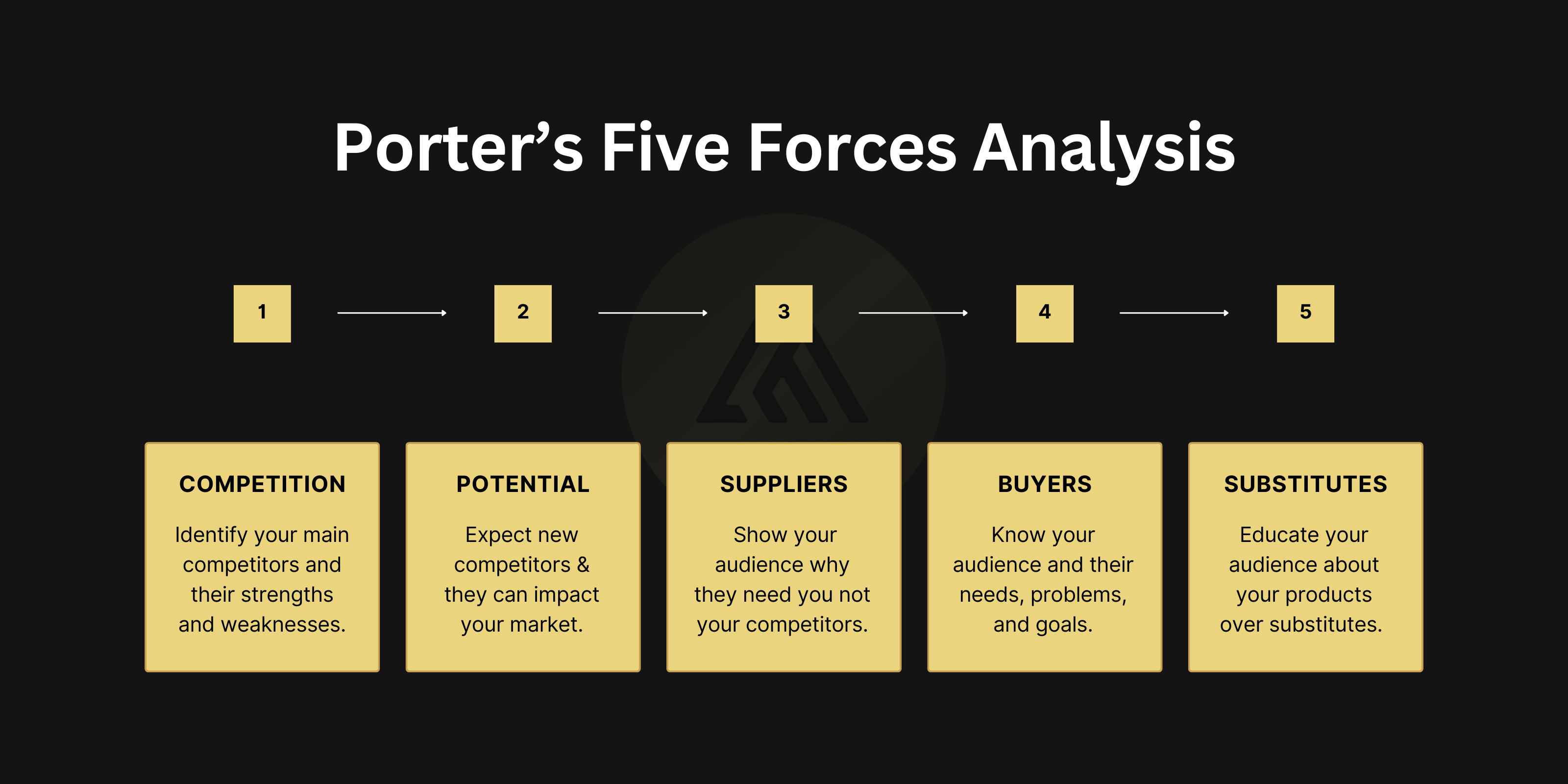
Step 4: Choose Which Digital Marketing Channels to Focus On
The fourth step in creating a digital marketing plan is to choose which digital marketing channels to focus on.
Digital marketing channels are platforms and tools that you can use to communicate with your target audience and deliver your value proposition.
There are many types of digital marketing channels, such as:
Websites
Your website is your online hub where you can showcase your brand, products, services, content, and offers.
It is also where you can capture leads, generate sales, and provide customer service.
Email Marketing
Email marketing is one of the most effective and cost-efficient digital marketing channels.
It allows you to build relationships with your subscribers, deliver personalized messages, and drive conversions.
Social Media Marketing
Social media marketing is a great way to increase your brand awareness, reach new audiences, engage with your followers, and drive traffic to your website.
You can use platforms like Facebook, Instagram, Twitter, LinkedIn, YouTube, Pinterest, TikTok, etc.
Organic Search (SEO)
Search engine optimization (SEO) is the process of improving your website’s visibility and relevance on search engines like Google and Bing.
It involves optimizing your site’s structure, content, keywords, links, and other factors to rank higher for relevant queries.
Paid Search (SEM)
Search engine marketing (SEM) is the process of using paid ads to appear on search engines for specific keywords.
It involves creating and managing campaigns on platforms like Google Ads and Bing Ads to drive qualified traffic to your website.
Mobile Marketing
Mobile marketing is the process of reaching and engaging with your audience on their mobile devices. It involves optimizing your website for mobile devices, creating mobile apps, using SMS and push notifications, etc.
Display Ads
Display advertising is the process of using banner ads, video ads, or other visual formats to appear on websites or apps that are relevant to your audience.
It involves creating and managing campaigns on platforms like Google Display Network or Facebook Audience Network to increase your brand awareness and drive traffic to your website.
Affiliate Marketing
Affiliate marketing is the process of partnering with other websites or influencers who promote your products or services to their audience in exchange for a commission.
It involves creating and managing programs on platforms like Amazon Associates or ShareASale to generate more sales and referrals.
Video Marketing
Video marketing is the process of using video content to showcase your brand, products, services, content, and offers.
It involves creating and distributing videos on platforms like YouTube, Vimeo, or Facebook Watch to increase your brand awareness, reach new audiences, engage with your viewers, and drive traffic to your website.
Instant Messaging (IM) Marketing
Instant messaging marketing is the process of using chat apps like WhatsApp, Facebook Messenger, or WeChat to communicate with your audience in real-time.
It involves creating and managing chatbots, broadcasts, or groups to provide customer service, deliver personalized messages, and drive conversions.
Online Public Relations
Online public relations is the process of building and maintaining a positive image and reputation for your brand online.
It involves creating and distributing press releases, articles, or stories on platforms like PRWeb, HARO, or Medium to increase your brand awareness, reach new audiences, and generate backlinks.
Influencer Marketing
Influencer marketing is the process of collaborating with influential people who have a large and loyal following on social media or other platforms.
It involves creating and managing campaigns on platforms like AspireIQ, Upfluence, or FameBit to increase your brand awareness, reach new audiences, and drive conversions.
To choose which digital marketing channels to focus on, you need to consider several factors such as:
Your Goals: Which channels are most aligned with your digital marketing goals? For example, if you want to generate more leads, you may want to focus on email marketing or paid search. If you want to increase brand awareness, you may want to focus on social media or video marketing.
Your Audience: Which channels are most preferred by your target audience? For example, if you want to reach millennials or Gen Zs, you may want to focus on Instagram or TikTok. If you want to reach professionals or B2B buyers, you may want to focus on LinkedIn or email.
Your Budget: Which channels are most cost-effective for your budget? For example, if you have a limited budget, you may want to focus on organic search or social media. If you have a larger budget, you may want to invest in paid search or display ads.
Your Skills: Which channels are most suitable for your skills? For example, if you have strong design or video production skills, you may want to focus on video marketing or display ads. If you have strong writing or copywriting skills, you may want to focus on email marketing or SEO.
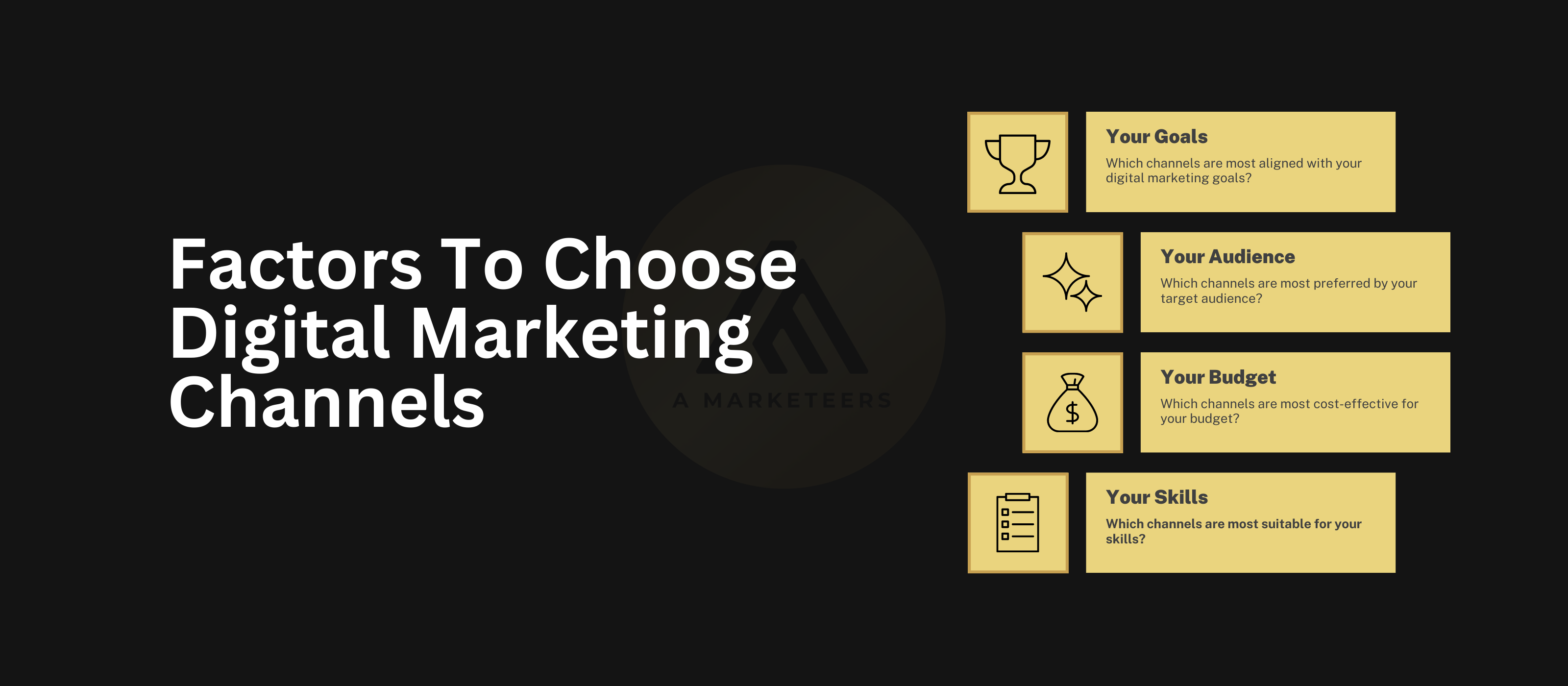
You don’t have to use all the digital marketing channels available. You should focus on the ones that will give you the best results for your goals, audience, budget, and skills.
Step 5: Set Defined Metrics to Review and Improve Performance
The fifth step in creating a digital marketing plan is to set defined metrics to review and improve performance.
Metrics are quantitative indicators that help you measure the success of your digital marketing activities. They help you track and analyze your progress and performance against your goals and objectives.
To set defined metrics, you need to follow these steps:
Identify Key Performance Indicators (KPIs)
KPIs are the most important metrics that directly relate to your goals and objectives.
For example, if your goal is to increase website traffic, your KPIs could be sessions, users, page views, bounce rate, etc.
If your goal is to generate more leads, your KPIs could be conversions, conversion rate, cost per lead, etc.
Choose Relevant Metrics for Each Channel
Each digital marketing channel has its specific metrics that help you measure its effectiveness.
For example, for email marketing, some of the metrics are open rate, click-through rate, unsubscribe rate, etc.
For social media marketing, some of the metrics are followers, engagement rate, reach, impressions, etc. You should choose the metrics that are relevant for each channel you use.
Set Benchmarks and Targets for Each Metric
Benchmarks are the average or standard values for each metric based on industry norms or historical data.
Targets are the desired values for each metric based on your objectives or expectations.
For example, if the average open rate for email marketing in your industry is 20%, that could be your benchmark.
If you want to achieve a 25% open rate for email marketing in 2023, that could be your target. You should set realistic and attainable benchmarks and targets for each metric.
Setting defined metrics will help you:
Monitor and evaluate your digital marketing performance over time.
Identify and address any issues or gaps in your digital marketing activities.
Optimize and improve your digital marketing strategies and tactics based on data-driven insights.
Step 6: Get Stakeholder Buy-in and Break Marketing Projects Into Actionable Tasks
The sixth step in creating a digital marketing plan is to get stakeholder buy-in and break marketing projects into actionable tasks.
Stakeholders are the people or groups who have an interest or influence in your digital marketing activities.
They can include your internal team members, managers, executives, customers, partners, suppliers, etc.
Getting stakeholder buy-in is crucial for the success of your digital marketing plan.
It helps you:
Align your digital marketing goals with your business vision and mission.
Gain support and approval for your digital marketing budget and resources.
Avoid conflicts and misunderstandings among different stakeholder groups.
Increase collaboration and communication among different stakeholder groups.
Enhance accountability and ownership for your digital marketing activities.
To get stakeholder buy-in, you need to:
Identify Your Key Stakeholders: Who are the people or groups who have a stake or influence in your digital marketing activities? What are their roles, responsibilities, expectations, and needs?
Communicate Your Value Proposition: What are the benefits of your digital marketing plan for each stakeholder group? How will your digital marketing plan help them achieve their goals or solve their problems?
Address Objections and Concerns: What are the potential risks or challenges of your digital marketing plan for each stakeholder group? How will you mitigate or overcome them?
Involve Them in the Process: How can you engage each stakeholder group in your digital marketing planning and execution? How can you solicit their feedback and input?
Show Them the Results: How will you measure and report the outcomes of your digital marketing activities to each stakeholder group? How will you celebrate and acknowledge their contributions?
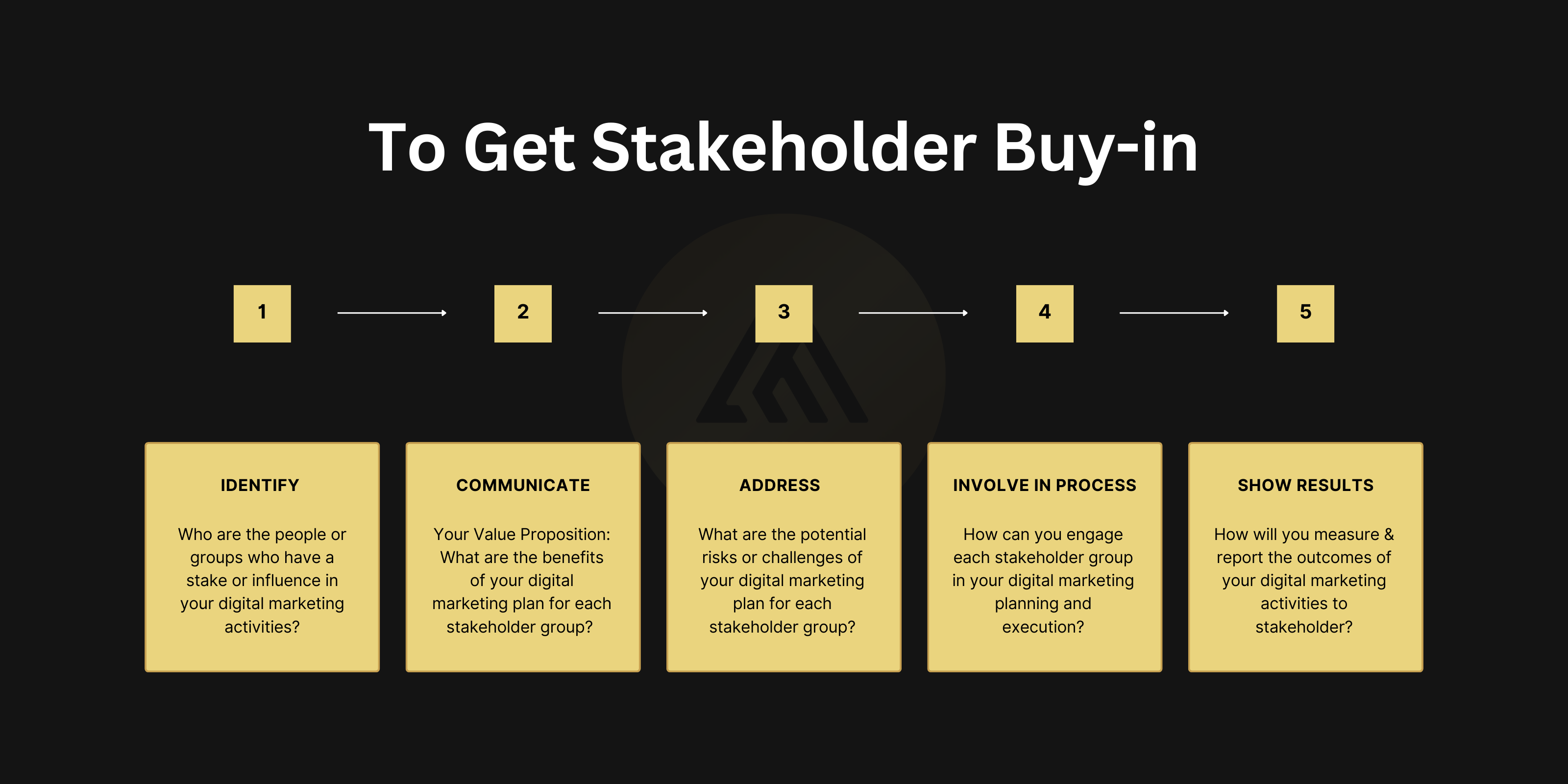
Breaking marketing projects into actionable tasks is also essential for the success of your digital marketing plan.
It helps you:
Organize and prioritize your digital marketing activities.
Assign roles and responsibilities to your team members.
Manage your time and resources efficiently.
Track and monitor your progress and performance.
Adjust and improve your digital marketing strategies and tactics.
To break marketing projects into actionable tasks, you need to:
Define the Scope and Deliverables of Each Project: What are the specific outputs or outcomes of each project? What are the quality standards and criteria for each project?
Break Down Each Project Into Smaller Tasks: What are the steps or actions required to complete each project? How long will each task take? What are the dependencies or prerequisites for each task?
Assign Tasks to Team Members: Who will be responsible for completing each task? What are their skills, availability, and preferences?
Set Deadlines and Milestones for Each Task: When will each task start and finish? What are the key dates or events that mark the completion or progress of each task?
Use a Project Management Tool: How will you organize, track, and manage your tasks and projects? What tool or system will you use to communicate, collaborate, and coordinate with your team members?
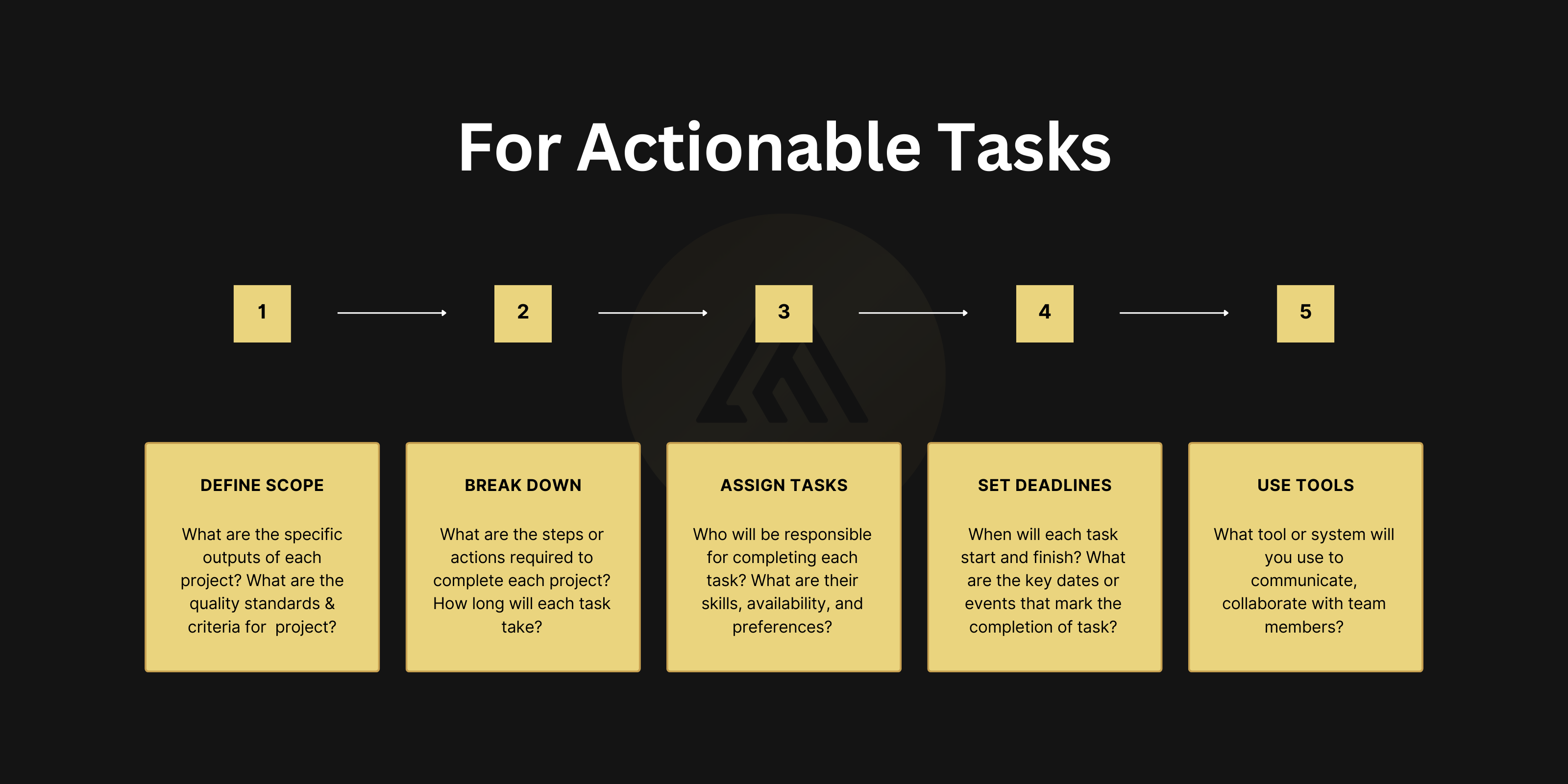
Getting stakeholder buy-in and breaking marketing projects into actionable tasks will help you execute your digital marketing plan effectively and efficiently.
Step 7: Design and Optimize Your Digital Marketing Content and Assets
The seventh and final step in creating a digital marketing plan is to design and optimize your digital marketing content and assets.
Content and assets are the materials that you create and distribute on your digital marketing channels to attract, engage, and convert your audience.
They can include:
Blog Posts: Blog posts are articles that provide valuable information, tips, insights, or stories to your audience. They can help you rank higher on search engines, drive traffic to your website, and establish your authority and credibility.
Visual Content: Visual content includes images, videos, infographics, charts, graphs, etc. that complement or enhance your written content. They can help you capture attention, increase engagement, and simplify complex information.
Premium Content Assets: Premium content assets are high-value materials that you offer to your audience in exchange for their contact information or other actions. They can include ebooks, whitepapers, reports, case studies, webinars, tools, etc. They can help you generate leads, nurture prospects, and demonstrate your expertise and value proposition.
Landing Pages: Landing pages are web pages that are designed to persuade your visitors to take a specific action, such as subscribing to your email list, downloading your ebook, registering for your webinar, etc. They can help you increase conversions and grow your audience.
Email Campaigns: Email campaigns are a series of emails that you send to your subscribers to provide them with relevant and personalized content and offers. They can help you build relationships, deliver value, and drive sales.
Social Media Posts: Social media posts are messages that you share on your social media platforms to communicate with your followers and reach new audiences. They can include text, images, videos, links, etc. They can help you increase your brand awareness, reach new audiences, engage with your followers, and drive traffic to your website.
Ads: Ads are paid placements that you use to promote your brand, products, services, content, or offers on search engines or other websites or apps. They can include text ads, display ads, video ads, etc. They can help you increase your visibility, reach new audiences, and drive qualified traffic to your website.
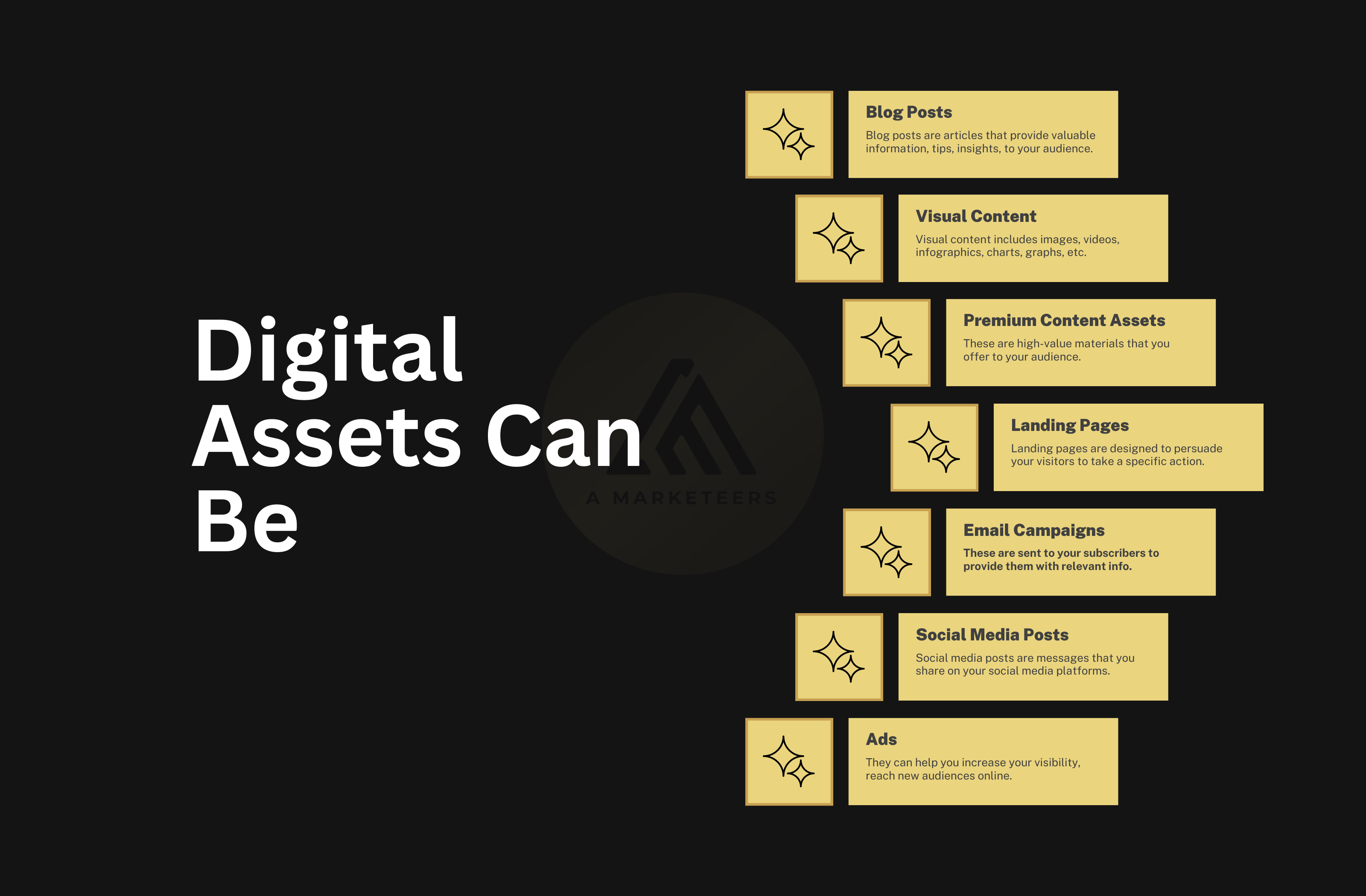
To design and optimize your digital marketing content and assets, you need to:
Follow Best Practices for Each Type of Content and Asset
Each type of content and asset has its guidelines and standards that you should follow to ensure its quality and effectiveness.
For example, for blog posts, you should use catchy headlines, clear structure, relevant keywords, internal and external links, etc.
For visual content, you should use high-quality images, videos, infographics, etc. that match your brand identity and message.
For premium content assets, you should use compelling titles, descriptions, calls-to-action, etc. that entice your audience to download or access them.
Align Your Content and Assets With Your Goals, Audience, And Channels
Your content and assets should be consistent with your digital marketing goals, audience, and channels.
For example, if your goal is to generate more leads, your content and assets should provide value and offer solutions to your audience’s problems.
If your audience is mostly millennials, your content, and assets should use a casual and conversational tone and style.
If your channel is social media, your content, and assets should be engaging, shareable, and optimized for each platform.
Test, Measure, And Improve Your Content and Assets
You should constantly test, measure, and improve your content and assets based on their performance.
For example, you can use tools like Google Analytics, HubSpot, or Hotjar to track metrics like traffic, engagement, conversions, bounce rate, etc. for each type of content and asset.
You can also use tools like Google Optimize, Unbounce, or Optimizely to run A/B tests or multivariate tests to compare different versions of your content and assets.
Based on the results, you can make changes or improvements to enhance their effectiveness.
Designing and optimizing your digital marketing content and assets will help you deliver value to your audience and achieve your digital marketing goals.
Step 8: Engage with Your Audience and Stakeholders Through Feedback, Questions, and Suggestions
The eighth step in creating a digital marketing plan is to engage with your audience and stakeholders through feedback, questions, and suggestions.
This step is important for ensuring that your digital marketing plan is meeting the needs and expectations of your audience and stakeholders.
It also helps you build trust, loyalty, and advocacy among them.
To engage with your audience and stakeholders through feedback, questions, and suggestions, you need to:
Encourage Feedback
You should encourage feedback from your audience and stakeholders throughout your digital marketing plan.
Feedback can help you improve your products, services, content, and offers based on your audience’s and stakeholders’ opinions and preferences.
You can use various methods to collect feedback, such as surveys, polls, quizzes, comments, reviews, ratings, etc. on your website, email, social media, etc.
You can also use tools like Hotjar, Typeform, or Qualtrics to create and distribute your feedback forms.
Answer Questions
You should answer questions from your audience and stakeholders promptly and professionally.
Questions can help you clarify any doubts or confusion that your audience and stakeholders may have about your products, services, content, or offers.
You can use various channels to answer questions, such as email, phone, chat, social media, etc. You can also use tools like WhatsApp, Facebook Messenger, or WeChat to communicate with your audience and stakeholders in real time.
Implement Suggestions
You should implement suggestions from your audience and stakeholders whenever possible and appropriate.
Suggestions can help you innovate and create new products, services, content, or offers that meet your audience’s and stakeholders’ needs and expectations.
You can use various methods to collect suggestions, such as brainstorming sessions, focus groups, interviews, etc.
You can also use tools like Asana, Trello, or Monday to manage and execute your suggestions.
Show Appreciation
You should show appreciation to your audience and stakeholders for their feedback, questions, and suggestions.
Appreciation can help you build rapport and loyalty with your audience and stakeholders. It can also motivate them to continue providing you with valuable input and support.
You can use various ways to show appreciation, such as thank-you notes, rewards, recognition, etc.
You can also use tools like Sendoso, BambooHR, or Bonusly to send personalized gifts or incentives to your audience and stakeholders.
According to a study by Harvard Business Review, engaging with your customers through feedback, questions, and suggestions can increase customer satisfaction by 20%, customer retention by 37%, and revenue by 25%.

Engaging with your stakeholders through feedback, questions, and suggestions can also improve collaboration, communication, and alignment among different stakeholder groups.
Therefore, engaging with your audience and stakeholders through feedback, questions, and suggestions is a vital step in creating a digital marketing plan for your business in 2023.
Step 9: Use Keywords, Meta Tags, Links, and Other SEO Elements to Optimize Your Digital Marketing Content and Assets for Search Engines
The ninth step in creating a digital marketing plan is to use keywords, meta tags, links, and other SEO elements to optimize your digital marketing content and assets for search engines.
This step is essential for increasing your visibility, relevance, and authority on search engines like Google and Bing.
It also helps you drive more organic traffic to your website.
To use keywords, meta tags, links, and other SEO elements, you need to:
Do Keyword Research
You should do keyword research to find out what words or phrases your audience is using to search for your products or services online.
You should use tools like Google Keyword Planner, Moz Keyword Explorer, or Ahrefs Keywords Explorer to find relevant, popular, and low-competition keywords for your digital marketing content and assets.
Use Keywords Strategically
You should use keywords strategically in your digital marketing content and assets.
You should include keywords in your headlines, subheadings, body text, images, videos, etc. You should also use keywords in your meta tags, such as title tags, meta descriptions, alt text, etc.
You should avoid keyword stuffing or overusing keywords, as this can harm your SEO performance.
Build Links
You should build links to your digital marketing content and assets from other reputable websites or sources.
Links are like votes of confidence that signal to search engines that your content and assets are valuable and trustworthy.
You should use tools like Moz Link Explorer, Ahrefs Backlink Checker, or SEMrush Backlink Analytics to find link opportunities and monitor your link profile.
Use Other SEO Elements
You should use other SEO elements to enhance your digital marketing content and assets for search engines.
For example, you can use schema markup to add structured data to your content and assets, such as ratings, reviews, prices, etc.
You can also use sitemaps to help search engines crawl and index your website more easily.
According to a study by BrightEdge, organic search drives 53% of all website traffic and 40% of revenue.

SEO is one of the most effective and cost-efficient digital marketing channels that can help you reach and convert your audience online.
Therefore, using keywords, meta tags, links, and other SEO elements is a crucial step in creating a digital marketing plan for your business in 2023.
Step 10: Test, Measure, and Improve Your Digital Marketing Plan
The tenth and final step in creating a digital marketing plan is to test, measure, and improve your digital marketing plan.
This step is crucial for ensuring that your digital marketing plan is working as intended and delivering the results you want.
It involves collecting and analyzing data from your digital marketing activities, identifying what is working and what is not, and making changes or improvements based on your findings.
To test, measure, and improve your digital marketing plan, you need to:
Use Analytics Tools to Track and Report Your Metrics
You should use analytics tools like Google Analytics, HubSpot, or Facebook Insights to track and report your metrics for each digital marketing channel.
These tools can help you measure your traffic, engagement, conversions, revenue, ROI, etc. You should also use dashboards or reports to visualize and communicate your data to your stakeholders.
Run A/B Tests or Multivariate Tests to Compare Different Versions of Your Content and Assets
You should run A/B tests or multivariate tests to compare different versions of your content and assets, such as headlines, images, colors, calls-to-action, etc.
These tests can help you determine which version performs better and why. You should use tools like Google Optimize, Unbounce, or Optimizely to run and manage your tests.
Conduct Surveys or Interviews to Get Feedback from Your Audience
You should conduct surveys or interviews to get feedback from your audience on your digital marketing content and assets.
These methods can help you understand their preferences, opinions, satisfaction, challenges, etc. You should use tools like SurveyMonkey, Typeform, or Qualtrics to create and distribute your surveys or interviews.
Implement Changes or Improvements Based on Your Data and Feedback
You should implement changes or improvements based on your data and feedback from your analytics tools, tests, surveys, or interviews.
These changes or improvements can include adding new features or benefits, removing unnecessary elements or steps, changing the layout or design, optimizing the speed or performance, etc.
You should also document and communicate your changes or improvements to your stakeholders and team members.
Repeat the Process Regularly and Consistently
You should repeat the process of testing, measuring, and improving your digital marketing plan regularly and consistently.
This will help you keep your digital marketing plan up-to-date and relevant to your audience and market. You should also set a schedule or frequency for reviewing and updating your digital marketing plan based on your goals and objectives.
Conclusion
A digital marketing plan for your business in 2023 is a dynamic and ongoing process that involves research, planning, execution, and evaluation.
This blog post has given you the steps to create a digital marketing plan that suits your goals and challenges.
But remember, a digital marketing plan is only effective if you implement it well. So don’t let your plan sit idle. Execute it with passion and precision, and see your business thrive online in 2023.
Here are the key takeaways:
Set your digital marketing goals and budget.
Know your ideal audience and their needs.
Study your competitors and your market position.
Pick the best digital marketing channels for your business.
Measure and improve your performance with data and feedback.
Get support from your stakeholders and assign tasks to your team.
Create and optimize your digital marketing content and assets.
Engage with your audience and stakeholders through feedback, questions, and suggestions.
Optimize your digital marketing content and assets for search engines.
Test, measure, and improve your digital marketing plan.
Do you need help or guidance to create a digital marketing plan for your business in 2023? Contact us today. Our team of experts at A Marketeers can help you with all aspects of digital marketing, from strategy to execution.
We can help you reach your online goals in 2023 and beyond.
